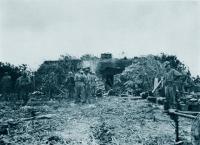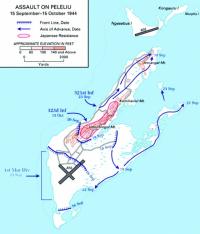Written By: Steven W. Rakow, Esq.

Steven W. Rakow, Esq.

Blockhouse encountered late on D-Day was reduced following morning.

Battle of Peleliu map.

15 Sept. 1944, the first wave of LVTs approach the beaches during the American assault on Peleliu.

Maj. Everett P. Pope, Medal of Honor recipient.

Men of 1st Marines advance around unexpected coral ridge inland from White beaches.
Sept. 15, 1944 – Nov. 27, 1944
In the summer of 1944, the successes of the Allies in the Pacific had set the stage for the invasion of the Philippines as well as continued island hopping towards the Japanese home islands. Along the axis of advance lay the Carolines Island chain. At the westernmost tip of the Carolines, the Palau Islands, and specifically the island of Peleliu, offered what the Japanese command deemed a favorable defensive position from which to attack and harass the Allies.
The 14th Imperial Infantry Division, fresh from years of fighting in Manchuria and led by Lt. Gen. Inoue Sadau, had the task of defending the Palau Islands against Allied advances. Lt. Gen. Sadau changed the Japanese tactics. They would put up token resistance at the beach and retreat deep inside tunnels and caves and use the terrain as a shield from which to wear down the invaders.
On the island of Peleliu, a six-square-mile island about 500 miles southeast of Manila, the task of setting in the defensive positions fell to Colonel Nakagawa Kunyo (Col. Nakagawa), the commanding officer of the 2nd Infantry Regiment. The central and southern parts of the island were relatively flat areas, including an airfield that provided little in the way of defensive advantage. Nakagawa’s orders to his troops were to fight to the last man.
Admiral Chester Nimitz, in May 1944, issued a warning order for the invasion of the Palaus. The task of conducting the invasion of the Palaus fell to Marine Major General Roy Geiger and the III Amphibious Corps. Geiger then tasked U.S. Marine Corps Major General William Rupertus’s 1st Marine Division with the landings on Peleliu and the U.S. Army’s 81st Division, under Major General Paul J. Mueller, with assaulting the islands of Anguar and Ulithi. The 81st Division was further tasked as the operational reserve.
Rupertus’s 1st Marine Division would land all three of its infantry regiments abreast on the western side of Peleliu and sweep east and north across the island. The 1st Marines, led by the legendary Col. Lewis B. “Chesty” Puller, who had already received four Navy Crosses, had the task of landing on the Division left, moving inland across the northern portion of the island, and taking the Umurbrogal Mountain cliffs. The 5th Marines, led by Col. Harold D. Harris, was tasked with attacking the Division center. From there, the 5th Marines would push across the central portion of Peleliu to secure the airfield and the eastern shore of the island. Col. Herman H. Hanneken commanded the 7th Marines. Rupertus assigned Hanneken’s regiment the right flank and securing of the southern part of the island.
The Army’s 81st Infantry Division, called the “Wildcats”, was led by Major-General Paul J. Mueller. The Wildcats consisted of three regimental combat teams, or RCTs: the 321st, commanded by Col. Robert F. Dark; the 322nd, commanded by Col. Benjamin W. Venable; and the 323rd, commanded by Col. Arthur P. Watson. The 321st and 322nd would attack Angaur, while the 323rd would be detached and used in the attack on Ulithi. Both islands were lightly defended.
Operation Stalemate II, The Battle of Peleliu, began with preparatory fires on September 12, 1944. After two days, Rear Admiral Jesse Oldendorff reported that his ships had run out of targets. On September 15, 1944, the landings commenced. While the initial landings were met with little resistance the first day, by the next day things were not going as planned.
On the left flank, Puller’s 1st Marines were hit hard and made little progress once they reached the high ground on the north of the island. In the center, the 5th and 7th Marines had taken the airfield and the 7th Marines had turned their attention towards the southern part of the island. By September 18th, Hanneken’s 7th Marines had secured the southern tip of the island. By September 19th, the 5th Marines had pushed across the island and had secured the eastern side of the island.
The successes of the 5th and 7th Marines, though engaged in tough combat, bore a stark contrast to the heavy casualties inflicted on the 1st Marines as they pushed hard into the mountain ridges. The Japanese were well dug in with fortified caves and tunnels used for mutually supporting fires from heavy machine guns. On the night of September 20th, the 1st Battalion, 1st Marines, led by Major Ray Davis, began the battle of “Bloody Nose Ridge”. It would be during this battle where Capt. Everitt Pope, leading Company C, would earn the Medal of Honor while leading his Marines in close quarters combat on Hill 154.
By September 23rd, Puller’s 1st Marines had suffered so many casualties that they ceased to be an effective fighting force. Although Maj.-Gen. Rupertus was reluctant to ask for help, Maj.-Gen. Geiger, after reviewing the casualties, ordered Col. Dark’s RCT 321 into action to relieve the beleaguered 1st Marines and continue the assault.
On September 24th, Marine Air came ashore and set up flight operations at the airfield. Because the enemy defenses on the ridges to the north of the airfield were so close, Marine pilots would often take off and drop their bombs before retracting their landing gear. The combined efforts of the Marine aviators along with the Army’s RCT 321 led to greater successes along the northern ridges.
While the RCT hammered away at the mountain ridgeline, Harris’s 5th Marines conducted the first shore-to-shore amphibious assault on a small island, Ngesebus, just to the north of Peleliu. The 5th Marines made quick work of the 470 Japanese defenders on Ngesebus with only 15 Marines killed and 33 wounded.
By early October, the 1st Marine Division had suffered more than 900 killed and 4500 wounded. Rupertus’s prediction of a quick, three-day battle was now a long, drawn out slugfest. Peleliu had become a major and bloody engagement for the 1st Marine Division. By the third week in October, Maj.-Gen. Geiger ordered the rest of Maj.-Gen. Mueller’s 81st Division into action to relieve the entire 1st Marine Division.
In late November, Japan’s Col. Nakagawa radioed his higher command that he was running low on food, ammunition, and men, but that the 2nd Infantry Regiment could still fight. And fight they did. After the final Japanese assault on November 24th, Col. Nakagawa committed ritual suicide. On November 27, 1944, Col. Watson of RCT 323 notified Maj.-Gen. Mueller that the island was secure. The Battle of Peleliu was over.
In the end, the U.S. suffered more than 1500 killed and 6700 wounded. Bloody Peleliu would prove to be the battle with the highest casualty rate for amphibious assault of the entire Pacific Theater of Operations. The battle took the 1st Marine Division out of action until April 1945, when they would again be used in the Battle of Okinawa. Eight Marines would receive the Medal of Honor for their actions on Peleliu. And while the Marines suffered the initial brunt of the action on Peleliu, the Army’s 81st Division suffered as well. The Wildcats would move on to New Caledonia for rest and refit; later moving to Leyte in the Philippines in May 1945 for mopping up operations. The 81st Infantry Division would end the war on occupation duty in Japan in September 1945 and was eventually deactivated.
Peleliu has been an often forgotten and overlooked Pacific battle. Its strategic importance has been questioned, yet MacArthur’s return to the Philippines went unhampered from its flank to the east. Aside from being overshadowed by MacArthur’s Philippine campaign, Peleliu was also overshadowed by Operation Market Garden in Europe. Despite what little attention historians have given Peleliu, the battle has been enshrined in Marine Corps History and is part of the legacy of the 1st Marine Division.
On a side note, on April 22, 1947, a Japanese lieutenant along with 26 soldiers and 8 sailors, came out of hiding on Peleliu and surrendered. They had held out in caves for over two years and did not know that the war had ended.
NEXT WEEK: OPERATION MARKET GARDEN
About the author: Steven W. Rakow is an Assistant State’s Attorney with the Office of the State’s Attorney for Worcester County handling major felony cases. He is a 1987 graduate of the U.S. Naval Academy and a 1996 graduate of the Salmon P. Chase College of Law. He served as a Marine Corps officer for 20 years – 5 active and 15 reserve – retiring as a lieutenant colonel in 2007. Mr. Rakow saw combat with the 1st Marine Division in Desert Shield/Desert Storm.
«Go back to the previous page.




